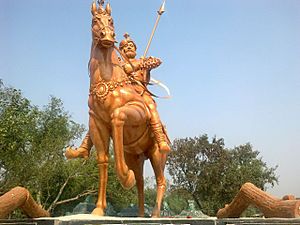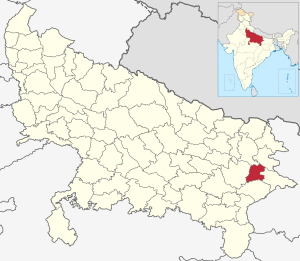Mau district facts for kids
Quick facts for kids
Mau district
|
|
|---|---|

Statue of Thakur Barisan Dev in Mau
|
|

Location of Mau district in Uttar Pradesh
|
|
| Country | |
| State | Uttar Pradesh |
| Division | Azamgarh |
| Headquarters | Mau |
| Tehsils | Mau Ghosi |
| Area | |
| • Total | 1,713 km2 (661 sq mi) |
| Population
(2011)
|
|
| • Total | 2,205,968 |
| • Density | 1,287.8/km2 (3,335.3/sq mi) |
| Demographics | |
| • Literacy | 80.16 per cent |
| • Sex ratio | 978 |
| Time zone | UTC+05:30 (IST) |
| Major highways | NH-24 |
Mau district is a district in the Uttar Pradesh state of India. Its main town and headquarters is Mau. This district is famous for its traditional handloom saree production, especially beautiful Sadiya silk sarees.
Mau became a separate district on November 19, 1988. Before that, it was part of Azamgarh. It is located in the south-eastern part of Uttar Pradesh. The district is surrounded by other districts: Ghazipur district to the south, Ballia to the east, Azamgarh district to the west, and Gorakhpur and Deoria to the north.
Contents
History of Mau District
Mau is a very old place with a rich history. People have lived here for at least 1500 years. Old remains and artifacts found in the area show that humans have been here for a long time. The earliest known inhabitants were the Nats, who lived along the Tamsa river.
Early Visitors and Settlers
Around 1028 A.D., a king named Syed Shalar Masood Ghazi came to this area with a large army. He left some of his people behind, including a Sufi saint named Baba Malik Tahir and his brother Malik Qasim. Today, parts of Mau city are named after them, like Malik Tahir Pura and Qasim Pura. You can also find the tomb of Malik Tahir there.
Between 1540 and 1545, Sher Shah Suri, a powerful emperor, visited Mau. He came to meet a Sufi saint named Syed Ahmad Wadva. One of Sher Shah's daughters, Mahvani, even settled permanently near the saint's shrine.
Later, the great Mughal emperor Akbar also passed through Mau. During his time, skilled workers and artists from places like Iran, Afghanistan, and Turkey came with the Mughal army and decided to stay here. They kept their traditional arts alive. Even today, the saree industry in Mau is a strong example of this ancient craftsmanship. It is also believed that one of Akbar's daughters, Jahan Aara, built a mosque here. Though the original mosque is gone, the area is still known as Shahi Qatra, and a Shahi Mosque stands there.
Role in Freedom Struggle
During India's fight for freedom, the people of Mau fully supported the movement. Mahatma Gandhi himself visited the Doharighat region of the district in 1939.
Becoming a Separate District
In 1932, Azamgarh became an independent district, and Mau was part of it. However, in 1988, the area of Mau was separated from Azamgarh to form its own district. On November 19, 1988, Mau officially became a new district. Kalpnath Rai, who was a Union Minister at the time, played a big role in this. He also helped bring many new developments to the city, like a new railway station and a stadium.
In Popular Culture
The district of Mau is mentioned in the famous 1924 novel A Passage to India by English author E. M. Forster. This book is about British rule in India and the Indian independence movement in the 1920s. In the story, one of the main characters, Aziz, moves to Mau and meets a school teacher named Cyril Fielding. The novel was also made into a film in 1984.
People and Languages
Population and Literacy
According to the 2011 census, Mau district has a population of about 2.2 million people. This is similar to the population of a country like Latvia. For every 1000 males, there are 978 females, which is called the sex ratio. The district's literacy rate is about 75.16%, meaning many people can read and write.
Religions in Mau District (2011)
| Religions in Mau district (2011) | ||||
|---|---|---|---|---|
| Religion | Percent | |||
| Hindus | 80.23% | |||
| Muslims | 19.43% | |||
| Other or not stated | 0.34% | |||
Mau district has a majority of Hindu residents, with a notable number of Muslim residents. In rural areas, Hindus make up over 90% of the population. However, in urban areas, Muslims are the majority.
Languages Spoken
In 2011, most people in Mau district spoke Bhojpuri (53.29%) as their first language. Hindi was spoken by 33.11% of the population, and Urdu by 13.51%. Bhojpuri is the local language of the district. The traditional script for Bhojpuri is called Kaithi.
Famous People from Mau District
Many notable people have come from Mau district.
Armed Forces
- Brigadier Mohammad Usman Masoodi (1912-1948): He was a high-ranking officer in the Indian Army. He was killed during the Indo-Pakistani War of 1947–1948 and was awarded the Maha Vir Chakra for his bravery.
Literature
- Ali Jawad Zaidi (1916–2004): An author and scholar who wrote 80 books. He received the Padma Shri award for his literary work.
- Fiza Ibn-e-Faizi (1923–2009): A modern poet who wrote in Urdu and Persian.
- Habib Al-Rahman Al-Azmi (1900–1992): A respected Islamic scholar.
- Kanhaiya Lal Misra (1903–1975): He served as the Advocate General of Uttar Pradesh from 1952 to 1969.
- Laxmi Narayan Mishra (1903–1987): A popular playwright and theater personality.
- Saeed-ur-Rahman Azmi Nadvi (1934 - ): Born in Mau, he is the Principal of Darul Uloom Nadwatul Ulama and Chancellor of Integral University.
- Qamar Abbas Qamar (1993 -): A contemporary poet who writes in Urdu and Persian.
- Shyam Narayan Pandey (1907–1991): A Hindi poet famous for his epic poem Haldighati. This poem is about the historic Battle of Haldighati between Emperor Akbar and Maharana Pratap.
Politician
- Habibur Rahman Nomani (1926–2005): An Indian politician from Uttar Pradesh who was part of the Indian National Congress party.
Singers
- Baleshwar Yadav: A well-known Bhojpuri Folk singer.
See also
 In Spanish: Distrito de Mau para niños
In Spanish: Distrito de Mau para niños

